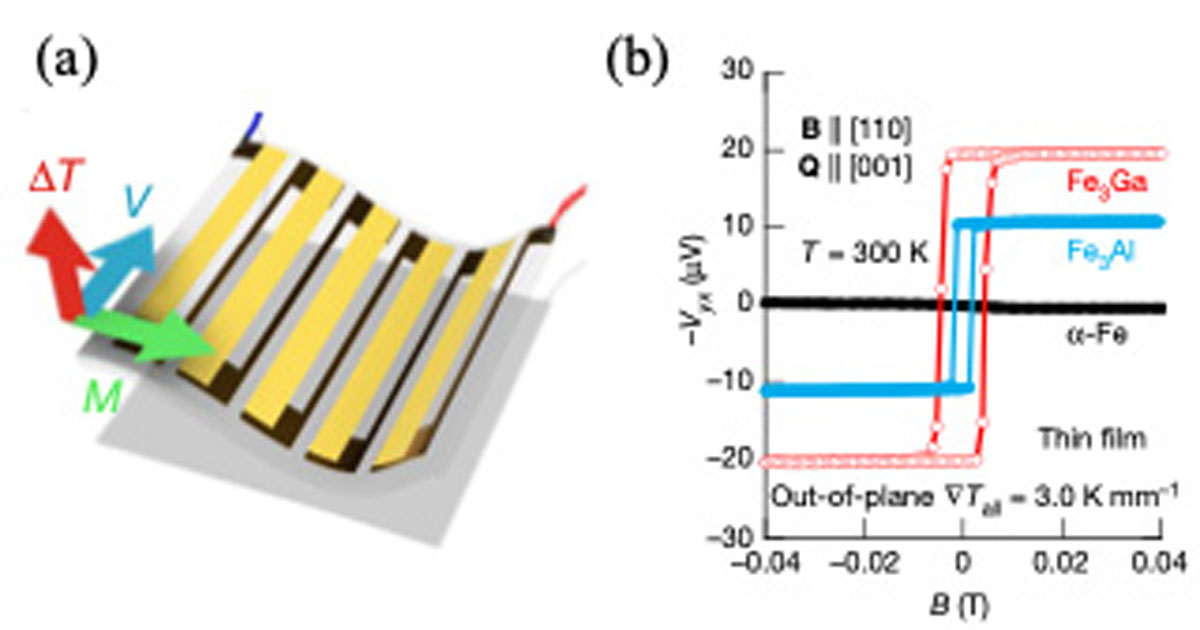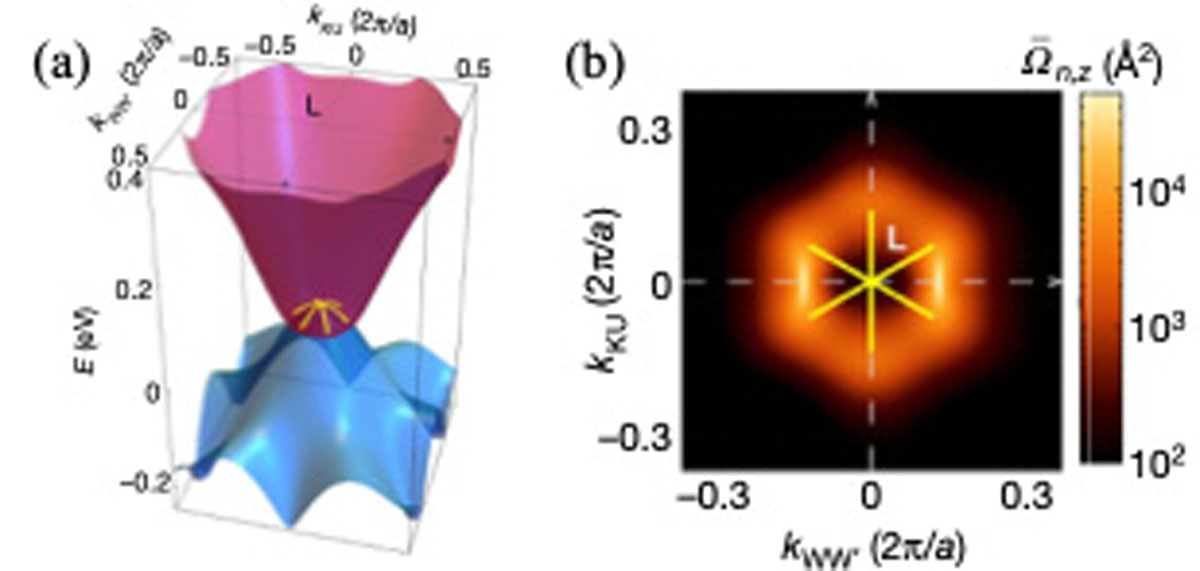Large Transverse Thermoelectric Effect in Iron-Based Binary Ferromagnets
Nakatsuji and Miwa Groups
Thermoelectricity, conversion of heat current into electric energy, provides key technology for versatile energy harvesting and heat current sensors. To date, the technology has relied on the longitudinal thermoelectric response known as the Seebeck effect. Its transverse counterpart in ferromagnets, the anomalous Nernst effect (ANE), has gained significant attention, as it has a number of potential benefits [1,2]. For example, the transverse geometry of the Nernst effect enables the efficient, large area and flexible coverage of a curved heat source (Fig. 1(a)). Moreover, the transverse geometry is hypothetically better suited for thermoelectric conversion, as the Ettingshausen heat current should support the Nernst voltage while the Peltier heat current may suppress the Seebeck voltage [3]. However, the anomalous Nernst effect is too small compared to the Seebeck effect for any thermoelectric application. Thus, it is essential to design a new class of materials that exhibit a large ANE at zero magnetic field.

Fig. 1. (a) Thermopiles based on the ANE. V, M, and ∆T is the voltage, magnetization, and temperature difference, respectively. (b) Magnetic field dependence of the Nernst voltage −Vyx for the thin films of Fe3Ga, Fe3Al and α-Fe. The temperature gradient in the sample (MgO substrate/Fe3Ga, Fe3Al, or α-Fe /MgO), ∇Tall, is monitored to be 3.0 Kmm-1. The temperature gradient in the Fe3Ga (Fe3Al) layer is estimated to be ∇T ≈ 0.86 K mm-1 (1.0 K mm-1).
To find candidate compounds efficiently, we carried out a high-throughput calculation to screen materials without synthesizing them first. Here we found two iron-based cubic compounds Fe3X (where X is Ga or Al) as materials suitable for designing such low-cost, flexible thermoelectric devices, reaching about 6 μVK-1 and 4 μVK-1 at room temperature, respectively, close to the highest value reported so far. Our successful fabrication of epitaxial Fe3Ga and Fe3Al thin films enables us to obtain a large ANE of about 4 μVK-1 and 2 μVK-1 at room temperature using an in-plane temperature gradient. Moreover, these Fe3Ga and Fe3Al films have in-plane magnetization with a coercivity BC of about 40 Oe and 20 Oe, respectively, and exhibit a spontaneous ANE at zero field (Fig. 1(b)) for the out-of-plane temperature gradient. These features enable us to design a much simpler thermoelectric device than the conventional Seebeck analogues.
The comparison between experiment and theory indicates that the Fermi energy tuning to the nodal web is the key for the substantial enhancement in the transverse thermoelectric coefficient, reaching a value of about 5 AK-1m-1with logarithmic temperature dependence. Figure 2(a) shows a schematic of the nodal web, a flat band structure made of interconnected nodal lines. The Berry curvature is particularly enhanced at the momenta connecting the edge of the nodal web around the L point on the Brillouin zone boundary, extending over a quasi-2D area spanned by the web (Fig. 2(b)). These results suggest that the strongly enhanced Berry curvature occurs near the momenta originally belonging to the flat nodal web, such as the one around the L point.

Fig. 2. (a) Energy dispersion of the conduction band (red) and the valence band (blue) around the L point on the BZ boundary for Fe3Ga. The nodal web is made of nodal lines, shown by the yellow lines (the same as in Fig. 2(b)), along which the flat portions of the conduction and the valence bands touch around the L point. (b) Contour plot of the Berry curvature Ωn,z of the lower-energy band n around the L point and nodal lines. The z direction is along [001] parallel to the magnetization.
Our discovery of the significant spontaneous transverse thermoelectric effects indicates that two iron-based compounds, Fe3Ga and Fe3Al, should be suitable for designing low-cost, flexible thermos electric generator by using their thin-film form. It is vital to enhance the coercivity further to achieve stable performance in daily use. Finally, it would be an interesting future direction to look for an enhanced output by combining the ANE with the spin Seebeck effect, both of which occur in the same transverse geometry [4].
References
- [1] A. Sakai et al., Nat. Phys. 14, 1119 (2018).
- [2] M. Ikhlas, T. Tomita et al., Nat. Phys. 13, 1085 (2017).
- [3] M. Mizuguchi and S. Nakatsuji, Sci. Technol. Adv. Mater. 20, 262 (2019).
- [4] A. Sakai et al., Nature 581, 53 (2020).
